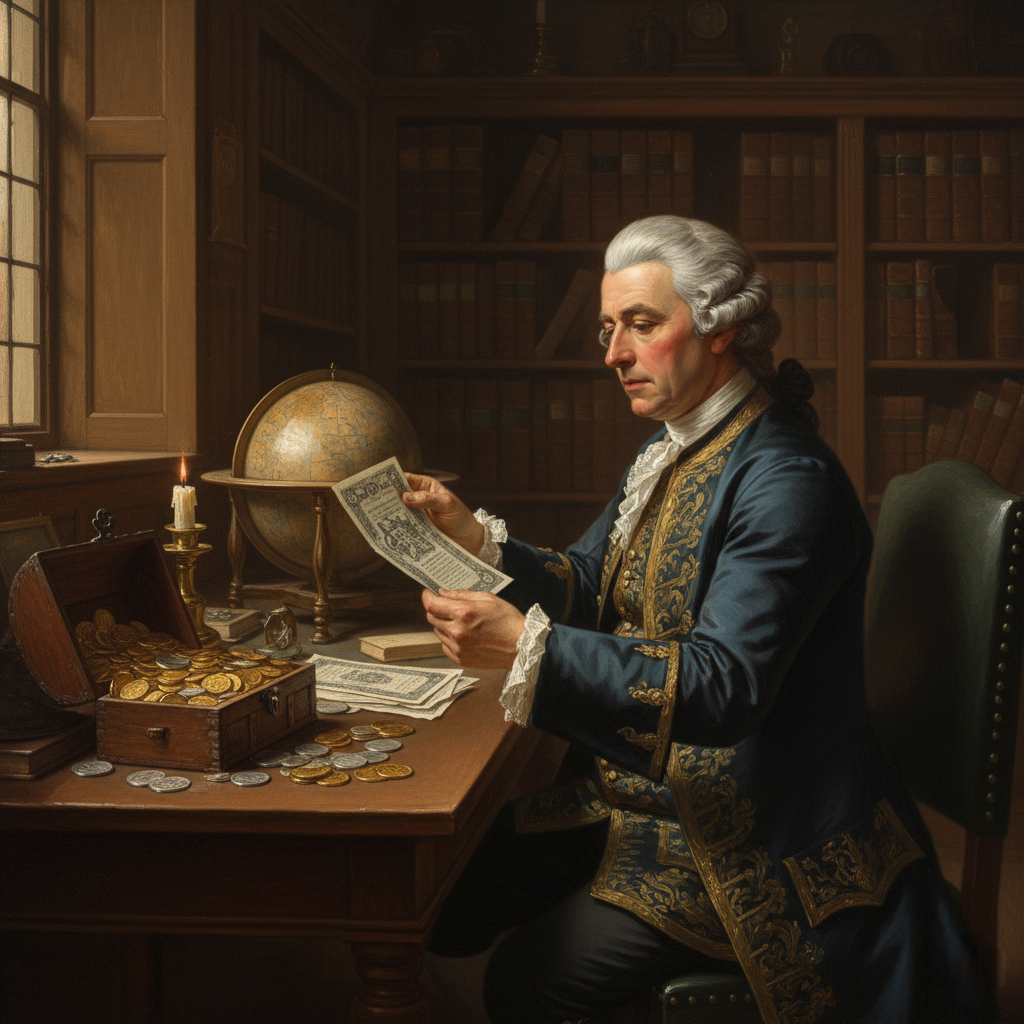Key Takeaways
- The invention of money was a solution to the problems of trade, relying completely on trust and shared agreement.
- The concepts behind banking—like keeping records of debt and lending money—started in ancient temples and merchant tables.
- The single most important idea still used today is fractional-reserve banking, invented by London goldsmiths, which allows banks to create new credit.
- Every major innovation in money, from coins to paper notes, was created to make commerce faster and easier.
Money’s Long Journey
The system we use for money today, with banks, credit, and digital payments, isn’t new. It’s the result of thousands of years of human creativity and problem-solving. This history shows that money’s evolution has always been about finding ways to trade more easily and building trust in that system.
The journey starts with simple trading and moves to complex ideas about debt and value. We’ll trace how our ancestors created the core concepts—like loans, paper receipts, and credit—that still run our financial world.
Part I: From Barter to Banks: The First Steps
Why Barter Didn’t Work
Imagine living 8,000 years ago. You’re a potter with extra pots, and you need grain. The original way to trade was barter—a direct swap.
The big problem was the “double coincidence of wants.” You had to find a farmer who not only had grain but also happened to need pottery at that exact moment. This “friction” made trading slow and often impossible. It showed a need for a universal item that everyone would accept, even if they didn’t immediately need it.
The Invention of Credit and Early Banking Concepts
The first great leap wasn’t a physical coin, but an idea: the abstraction of value.
In ancient Mesopotamia (around 3,000 B.C.), people started using clay tablets to represent debt. Instead of trading actual grain, they wrote down a promise to pay grain later. This created a basic system of credit and debt record-keeping, where the value was in the promise (the record) and the trust in the social agreement, not the physical goods.
These early financial systems found a home in temples. Priests acted as secure guards, storing goods like grain and valuables. They were the world’s first bookkeepers, recording transactions and making loans to farmers and merchants. These temples were the earliest form of a bank, offering storage, savings, and credit.
Standardizing Money with Coins
While credit worked for locals, long-distance trade needed something portable and guaranteed. That solution was coinage.
Around 700 B.C., the first metal coins were introduced in Lydia (modern Turkey). These Lydian staters were stamped by a government. This stamp was a guarantee of the metal’s weight and purity. This simple act was revolutionary because it removed the hassle of weighing and testing metal every time you traded. For the first time, you could just count money, making trade dramatically faster and more reliable.
The Logistics of Paper Money
As civilizations grew, carrying large quantities of metal coins became too heavy for long-distance merchants.
The need for lighter money led to the invention of paper money. The earliest version was a promissory note—a simple, written promise to pay a sum of money later. This idea was formalized in China during the Song Dynasty (around 1020 AD). Merchants used receipts for their coin deposits, and the government eventually took over issuing these notes, calling them “flying cash”. This was the world’s first official paper currency, solving the logistical problem of heavy coins and showing that an IOU (I Owe You) could serve as money if enough people trusted the issuer.
Part II: Trade, Merchants, and the Start of Modern Finance
The Money Changers: The Birth of the Bank
In medieval Europe, trade was complicated because every region used different coins. This need for exchange created a new expert: the money changer, or bancheri, who worked at a wooden table called a bancus.
Their job was simple at first: swap foreign coins for local ones. But their role quickly expanded into essential banking concepts:
- Secure Deposits: Their tables became secure places for clients to leave cash.
- Paper Credit: They gave customers receipts for their deposits, which people soon began passing to others to settle debts—another form of paper money.
- Lending: With all that cash on hand, they began lending out a portion of the deposits.
These three activities—deposits, paper credit, and lending—are the core functions of banking today. The danger of this system was highlighted when a money changer failed; their table would be broken, giving us the word “bankruptcy” (banco rotto).
Early Prototypes of a Bank
Institutions began to emerge that show us how modern banking was taking shape:
- Banca Monte dei Paschi di Siena (1472): Founded in Italy, this is the world’s oldest continuously operating bank. It started as a public service to offer loans to the poor, showing that banks could serve a social good, not just private profit.
- The Medici Bank: This powerful family bank in Florence used an advanced structure, creating semi-independent branches across Europe. This strategy helped them manage risk, ensuring the failure of one branch wouldn’t ruin the whole company—a concept used by large financial institutions today.
Part III: How Goldsmiths Invented Modern Banking
A Crisis of Trust and the New Custodians
The true birth of modern banking took place in 17th-century London. Political instability led to a breakdown of trust in the government. Wealthy merchants feared the king might seize their assets, so they sought a secure place to store their gold and silver.
They turned to the goldsmiths, who already had strong vaults to protect their precious metals. The goldsmiths went from metal workers to financial custodians.
The Transferable Receipt
When a goldsmith accepted gold for safekeeping, they gave the depositor a receipt. The genius of this period was the realization that people didn’t need the physical gold to trade; they just needed the receipt, which promised the gold was there. These receipts became widely accepted as a new form of paper currency. This created a huge separation: the paper was now treated as valuable as the metal it represented.
The Core Concept: Fractional-Reserve Banking
The goldsmiths noticed that only a small portion of the gold they held was ever withdrawn at any one time. Quietly, they began to lend out the “surplus” gold and collected interest on these loans.
This was the conceptual leap of fractional-reserve banking—only keeping a fraction of deposits in reserve and lending out the rest. This practice is the single most important concept in modern finance because it allows banks to create credit and expand the money supply, driving economic growth.
The downside was immediately apparent. When King Charles II suddenly suspended state debt payments in 1672, many goldsmith-bankers failed. This 1672 Crisis was an early, painful lesson that while fractional-reserve banking is powerful, it carries a systemic liquidity risk (the risk that the bank won’t have enough ready cash when customers demand it).
Part IV: The Enduring Concepts and Modern Challenges
From Private Bank to Central Bank
The constant threat of liquidity crises proved that the system was too fragile to be left completely unregulated. This led to the creation of the Bank of England in 1694. It was set up to manage the government’s debt and quickly evolved to become the central authority that could step in to stabilize the financial system. The establishment of this central bank model, designed to manage money supply and act as a stabilizing force, became a global template.
The Persistence of Trust and Risk
The catastrophic global banking failures of the early 20th century (culminating in the Great Depression) showed that public trust was the system’s most fragile element. In response, governments worldwide began building regulations to protect depositors. This included creating systems of deposit insurance—a state guarantee that your money is safe—to remove the panic that causes bank runs.
Today, in the digital age, these ancient principles remain. When people can move billions of dollars with a click on a smartphone, the speed of panic is instant. The recent failure of institutions like Silicon Valley Bank shows that while technology has changed the mechanism, the core drivers of financial history—liquidity risk, over-leverage, and the balance between trust and fear—are the same ones that plagued the Roman temples and the London goldsmiths centuries ago.
Questions About Financial History
- What does fractional-reserve banking mean?
Fractional-reserve banking is the standard practice today. It means a bank keeps only a fraction (a part) of your deposit on hand and lends out the rest. This practice allows for economic growth but also makes the bank vulnerable to a bank run if everyone tries to take their money out at once.
- What is the difference between money and credit?
Money is a medium of exchange (like a coin or bill). Credit is the trust that allows you to receive money now in exchange for a promise to pay it back later. The earliest financial innovation was the clay tablet, which was a record of credit, showing that credit (the promise) often came before true money (the medium of exchange).
- Why did the early banks need a crisis of trust to start?
The very first banks (like the ancient temples and the goldsmiths’ vaults) became important because people distrusted the previous system or ruler. If people trust the government or the general system, they don’t need to find a third party to guard their wealth. Banking was born out of a perceived need for security and a safer place to keep assets.





